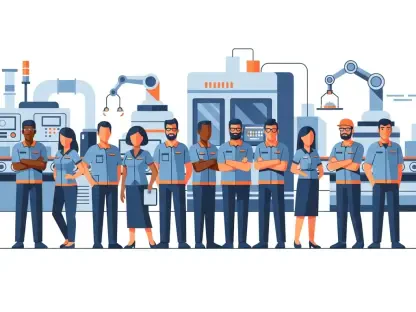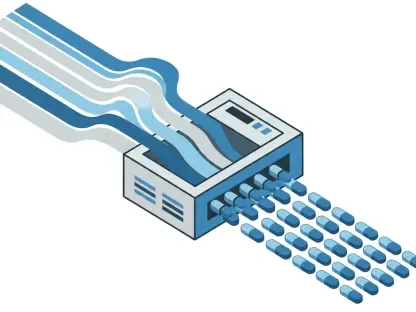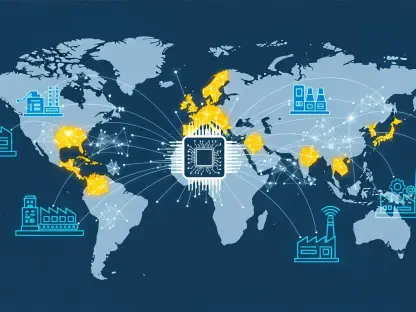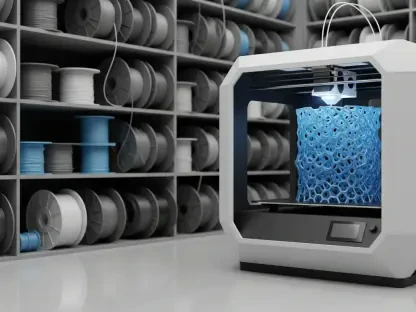Imagine a world where industrial equipment failures are anticipated and prevented long before they disrupt operations, saving billions in downtime costs and boosting efficiency across various sectors. The predictive maintenance market is turning this vision into reality, leveraging cutting-edge technologies to revolutionize how industries manage their assets. Valued at $5.19 billion in 2022, this market is projected to soar to an impressive $41.89 billion by 2030, driven by a remarkable compound annual growth rate (CAGR) of 29.80%. By utilizing tools such as artificial intelligence (AI), machine learning (ML), the Internet of Things (IoT), and big data analytics, predictive maintenance enables real-time monitoring of equipment health, identifies anomalies, and forecasts potential breakdowns. This proactive approach significantly reduces unplanned interruptions, lowers maintenance expenses, and enhances operational performance in diverse fields like manufacturing, energy, transportation, and healthcare. As a cornerstone of Industry 4.0 and smart factory initiatives, predictive maintenance is reshaping industrial strategies, moving away from outdated reactive and preventive models to a data-driven paradigm. This article explores the forces propelling this market’s rapid expansion, the innovative technologies at its core, the challenges hindering broader adoption, and the vast opportunities that lie ahead for businesses worldwide.
Technological Foundations and Market Drivers
The predictive maintenance market represents a seismic shift from traditional maintenance practices to a sophisticated, data-centric model that prioritizes foresight over reaction. Unlike reactive maintenance, which addresses failures only after they occur, or preventive maintenance, which operates on rigid schedules regardless of equipment condition, predictive maintenance harnesses real-time data to anticipate issues with remarkable precision. This transformation is particularly vital for industries where unexpected downtime can result in staggering financial losses, such as oil and gas, aviation, and heavy manufacturing. The ability to predict and prevent disruptions not only ensures smoother operations but also delivers substantial cost savings by addressing problems before they escalate into major setbacks. As industries increasingly prioritize efficiency and resilience, this approach has become a linchpin for maintaining competitive advantage in a fast-evolving global landscape.
Central to the success of predictive maintenance are cutting-edge technologies that enable continuous monitoring and intelligent analysis. IoT sensors embedded in machinery collect vast amounts of performance data, which machine learning algorithms process to identify patterns and predict potential failures. Meanwhile, cloud-based platforms provide scalability and accessibility, allowing companies to manage maintenance operations across multiple locations without significant infrastructure investments. Emerging innovations like digital twins—virtual replicas of physical assets—offer simulations for better forecasting, while augmented reality (AR) tools support remote troubleshooting and technician training. These advancements collectively push the boundaries of operational efficiency, positioning predictive maintenance as a transformative force in industrial management.
Emerging Trends Shaping Industry Evolution
One of the most prominent trends in the predictive maintenance market is the growing integration of AI and machine learning, which continuously enhance the accuracy of failure predictions. These technologies adapt and improve over time, enabling automated decision-making with minimal human intervention and streamlining maintenance processes. This shift toward automation reduces operational overhead and allows businesses to focus on core activities while ensuring equipment reliability. As AI models become more sophisticated, their ability to detect subtle anomalies in complex systems further solidifies predictive maintenance as a critical tool for modern industries aiming to stay ahead in a technology-driven era.
Another defining trend is the widespread adoption of cloud-based platforms, which offer unmatched flexibility and cost-effectiveness. These solutions are particularly appealing to small and medium-sized enterprises (SMEs) that seek to implement predictive maintenance without the burden of hefty upfront costs for hardware and infrastructure. Cloud platforms also facilitate seamless integration across geographically dispersed facilities, supporting global operations with ease. Coupled with the proliferation of IoT networks, which generate actionable insights from connected devices, this trend aligns closely with the principles of Industry 4.0, where real-time data and interconnected systems drive smart manufacturing and operational excellence.
Barriers to Widespread Implementation
Despite the transformative potential of predictive maintenance, significant challenges stand in the way of its universal adoption across industries. High initial costs pose a major barrier, as implementing these systems requires substantial investments in advanced hardware like IoT sensors, software for AI-driven analytics, and cloud infrastructure. Beyond the financial outlay, organizations must also allocate resources for training staff to effectively use these technologies. This economic hurdle is especially daunting for SMEs, which may struggle to justify the expense despite the long-term benefits of reduced downtime and maintenance savings. Addressing this issue remains critical to democratizing access to predictive maintenance solutions.
Additionally, the complexities of data management present a formidable obstacle in deploying predictive maintenance systems. These solutions rely on processing enormous volumes of unstructured data, demanding robust infrastructure and skilled personnel to ensure accurate analysis and actionable outcomes. Many companies face difficulties integrating predictive maintenance tools with existing enterprise systems such as enterprise resource planning (ERP) or computerized maintenance management systems (CMMS), often resulting in operational inefficiencies. On top of this, data security concerns loom large, particularly in sectors like healthcare and defense, where breaches of sensitive information could have catastrophic repercussions. Overcoming these technical and security challenges is essential for broader market penetration.
Opportunities for Innovation and Expansion
Amid the challenges, the predictive maintenance market brims with opportunities for growth as industries worldwide embrace digital transformation. By minimizing unplanned downtime, extending the lifespan of critical equipment, and optimizing resource allocation, this approach drives significant cost savings while supporting broader sustainability goals. Reducing waste and energy consumption through efficient maintenance aligns with global environmental priorities, offering businesses a dual benefit of profitability and social responsibility. As industries strive to meet regulatory standards and consumer expectations for sustainable practices, predictive maintenance emerges as a key enabler of responsible industrial progress.
Technological advancements further amplify the potential for market expansion, making predictive maintenance more accessible than ever before. Innovations in cloud computing and edge analytics lower the entry barrier by reducing the need for extensive on-site infrastructure, thus benefiting SMEs and larger enterprises alike. Meanwhile, integrating predictive maintenance with emerging tools like blockchain for enhanced data security and AR/VR for remote collaboration opens fresh avenues for innovation. These developments not only improve operational efficiency but also position predictive maintenance as an indispensable component of modern industrial ecosystems, paving the way for smarter, more resilient operations in an increasingly competitive global market.
Reflecting on Past Growth and Future Pathways
Looking back, the predictive maintenance market carved a remarkable trajectory, starting from a valuation of $5.19 billion in 2022 and setting sights on reaching $41.89 billion by 2030. The journey was fueled by rapid advancements in AI, IoT, and cloud technologies, which redefined how industries approached equipment management. Challenges like steep upfront costs and data management complexities tested the resolve of many adopters, yet the promise of reduced downtime and operational savings kept momentum alive. North America led the charge with its robust technological infrastructure, while other regions steadily caught up through industrial digitization efforts.
Moving forward, the focus should shift to actionable strategies that address lingering barriers and unlock untapped potential. Stakeholders must prioritize developing cost-effective solutions to bring predictive maintenance within reach of smaller enterprises. Investments in workforce training and cybersecurity measures will be crucial to overcoming skill shortages and data risks. Additionally, fostering collaborations between technology providers and industry players can accelerate innovation, ensuring that predictive maintenance continues to evolve in step with emerging needs. As digital transformation deepens, this market stands poised to redefine industrial resilience, offering a blueprint for efficiency and sustainability in the years ahead.









